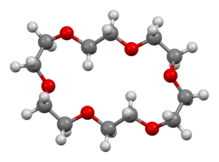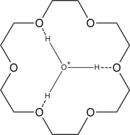18-Crown-6

| |

| |

| |
| Names | |
|---|---|
| Preferred IUPAC name
1,4,7,10,13,16-Hexaoxacyclooctadecane | |
| Identifiers | |
3D model (JSmol)
|
|
| 1619616 | |
| ChEBI | |
| ChEMBL | |
| ChemSpider | |
| ECHA InfoCard | 100.037.687 |
| EC Number |
|
| 4535 | |
PubChem CID
|
|
| UNII | |
CompTox Dashboard (EPA)
|
|
| |
| |
| Properties | |
| C12H24O6 | |
| Molar mass | 264.315 g/mol |
| Density | 1.237 g/cm3 |
| Melting point | 37 to 40 °C (99 to 104 °F; 310 to 313 K) |
| Boiling point | 116 °C (241 °F; 389 K) (0.2 Torr) |
| 75 g/L | |
| Hazards | |
| GHS labelling: | |

| |
| Warning | |
| H302, H315, H319, H335 | |
| P261, P264, P270, P271, P280, P301+P312, P302+P352, P304+P340, P305+P351+P338, P312, P321, P330, P332+P313, P337+P313, P362, P403+P233, P405, P501 | |
| Related compounds | |
Related compounds
|
Dibenzo-18-crown-6 Triglyme Hexaaza-18-crown-6 |
Except where otherwise noted, data are given for materials in their standard state (at 25 °C [77 °F], 100 kPa).
| |
18-Crown-6 is an organic compound with the formula [C2H4O]6 and the IUPAC name of 1,4,7,10,13,16-hexaoxacyclooctadecane. It is a white, hygroscopic crystalline solid with a low melting point.[1] Like other crown ethers, 18-crown-6 functions as a ligand for some metal cations with a particular affinity for potassium cations (binding constant in methanol: 106 M−1). The point group of 18-crown-6 is S6. The dipole moment of 18-crown-6 is solvent- and temperature-dependent. Below 25 °C, the dipole moment of 18-crown-6 is 2.76 ± 0.06 D in cyclohexane and 2.73 ± 0.02 in benzene.[2] The synthesis of the crown ethers led to the awarding of the Nobel Prize in Chemistry to Charles J. Pedersen.
Synthesis
[edit]This compound is prepared by a modified Williamson ether synthesis in the presence of a templating cation:[3]
(CH2OCH2CH2Cl)2 + (CH2OCH2CH2OH)2 + 2 KOH → (CH2CH2O)6 + 2 KCl + 2 H2O
It can be also prepared by the oligomerization of ethylene oxide.[1] It can be purified by distillation, where its tendency to supercool becomes evident. 18-Crown-6 can also be purified by recrystallisation from hot acetonitrile. It initially forms an insoluble solvate.[3] Rigorously dry material can be made by dissolving the compound in THF followed by the addition of NaK to give [K(18-crown-6)]Na, an alkalide salt.[4]
Crystallographic analysis reveals a relatively flat molecule but one where the oxygen centres are not oriented in the idealized 6-fold symmetric geometry usually shown.[5] The molecule undergoes significant conformational change upon complexation.
Reactions
[edit]
18-Crown-6 has a high affinity for the hydronium ion H3O+, as it can fit inside the crown ether. Thus, reaction of 18-crown-6 with strong acids gives the cation . For example, interaction of 18-crown-6 with HCl gas in toluene with a little moisture gives an ionic liquid layer with the composition , from which the solid can be isolated on standing. Reaction of the ionic liquid layer with two molar equivalents of water gives the crystalline product .[1][6][7]
Applications
[edit]
18-Crown-6 binds to a variety of small cations, using all six oxygens as donor atoms. Crown ethers can be used in the laboratory as phase transfer catalysts.[8] Salts which are normally insoluble in organic solvents are made soluble by crown ether.[9] For example, potassium permanganate dissolves in benzene in the presence of 18-crown-6, giving the so-called "purple benzene", which can be used to oxidize diverse organic compounds.[1]
Various substitution reactions are also accelerated in the presence of 18-crown-6, which suppresses ion-pairing.[10] The anions thereby become naked nucleophiles. For example, using 18-crown-6, potassium acetate is a more powerful nucleophile in organic solvents:[1]
- [K(18-crown-6)+]OAc− + C6H5CH2Cl → C6H5CH2OAc + [K(18-crown-6)+]Cl−
The first electride salt to be examined with X-ray crystallography, [Cs(18-crown-6)2]+·e−, was synthesized in 1983. This highly air- and moisture-sensitive solid has a sandwich molecular structure, where the electron is trapped within nearly spherical lattice cavities. However, the shortest electron-electron distance is too long (8.68 Å) to make this material a conductor of electricity.[1]
References
[edit]- ^ a b c d e f Steed, Jonathan W.; Atwood, Jerry L. (2009). Supramolecular Chemistry (2nd ed.). Wiley. ISBN 978-0-470-51233-3.
- ^ Caswell, Lyman R.; Savannunt, Diana S. (January 1988). "Temperature and solvent effects on the experimental dipole moments of three crown ethers". J. Heterocyclic Chem. 25 (1): 73–79. doi:10.1002/jhet.5570250111.
- ^ a b Gokel, George W.; Cram, Donald J.; Liotta, Charles L.; Harris, Henry P.; Cook, Fred L. (1977). "18-Crown-6". Org. Synth. 57: 30. doi:10.15227/orgsyn.057.0030.
- ^ Jilek, Robert E.; Fischer, Paul J.; Ellis, John E. (2014). "Bis(1,2-Bis(Dimethylphosphano)Ethane)Tricarbonyltitanium(0) and Hexacarbonyltitanate(2−)". Inorganic Syntheses: Volume 36. Vol. 36. pp. 127–134. doi:10.1002/9781118744994.ch24. ISBN 9781118744994.
- ^ Dunitz, J. D.; Seiler, P. (1974). "1,4,7,10,13,16-Hexaoxacyclooctadecane". Acta Crystallogr. B30 (11): 2739. doi:10.1107/S0567740874007928.
- ^ Atwood, Jerry L.; Bott, Simon G.; Coleman, Anthony W.; Robinson, Kerry D.; Whetstone, Stephen B.; Means, C. Mitchell (December 1987). "The oxonium cation in aromatic solvents. Synthesis, structure, and solution behavior of ". Journal of the American Chemical Society. 109 (26): 8100–8101. doi:10.1021/ja00260a033.
- ^ Atwood, Jerry L.; Bott, Simon G.; Means, C. Mitchell; Coleman, Anthony W.; Zhang, Hongming; May, Michael T. (February 1990). "Synthesis of salts of the hydrogen dichloride anion in aromatic solvents. 2. Syntheses and crystal structures of and the related ". Inorganic Chemistry. 29 (3): 467–470. doi:10.1021/ic00328a025.
- ^ Liotta, C. L.; Berknerin, J. (2004). "18-Crown-6". In Paquette, L. (ed.). Encyclopedia of Reagents for Organic Synthesis. New York: J. Wiley & Sons. doi:10.1002/047084289X.rc261. ISBN 0471936235.
- ^ Wynn, David; et al. (1984). "The Solubility of Alkali-Metal Fluorides in Non-Aqueous Solvents With and Without Crown Ethers...". Talanta. 31 (11): 1036–1040. doi:10.1016/0039-9140(84)80244-1. PMID 18963717.
- ^ Cook, Fred L.; Bowers, Chauncey W.; Liotta, C. L. (November 1974). "Chemistry of naked anions. III. Reactions of the 18-crown-6 complex of potassium cyanide with organic substrates in aprotic organic solvents". The Journal of Organic Chemistry. 39 (23): 3416–3418. doi:10.1021/jo00937a026.
External links
[edit]Text is available under the CC BY-SA 4.0 license; additional terms may apply.
Images, videos and audio are available under their respective licenses.
![{\displaystyle {\ce {[H3O.18-crown-6]+))}](https://wikimedia.org/api/rest_v1/media/math/render/svg/05959c612544dc9b3cb3553c23497b6cb0b79eae)
![{\displaystyle {\ce {[H3O.18-crown-6]+[HCl2]^{-}.))3.8{\ce {C6H5Me))}](https://wikimedia.org/api/rest_v1/media/math/render/svg/f6c99a07eb7055bb324034bb06c5b326acac2040)
![{\displaystyle {\ce {[H3O.18-crown-6]+[HCl2]-))}](https://wikimedia.org/api/rest_v1/media/math/render/svg/4a39f9fa425e04e4fb9893a6534ec9ebe14ec13d)
![{\displaystyle {\ce {(H5O2)[H3O.18-crown-6]Cl2))}](https://wikimedia.org/api/rest_v1/media/math/render/svg/ea4d202cf03dca6460e22c323e76cdeaa4e4da33)
![{\displaystyle {\ce {[H3O+.18-crown-6][Cl-H-Cl]))}](https://wikimedia.org/api/rest_v1/media/math/render/svg/570b60b09f20cda7d97987382a006e776dd9ed9e)
![{\displaystyle {\ce {[K.18-crown-6][Cl-H-Cl])),}](https://wikimedia.org/api/rest_v1/media/math/render/svg/033a571d20719af08d7a5198f57da59afc23a226)
![{\displaystyle {\ce {[Mg.18-crown-6][Cl-H-Cl]2)),}](https://wikimedia.org/api/rest_v1/media/math/render/svg/abf6c19ea8d8195eea1d4679f2a696d69feb2f72)
![{\displaystyle {\ce {[H3O.18-crown-6][Cl-H-Cl])),}](https://wikimedia.org/api/rest_v1/media/math/render/svg/53c829dc937cd5208e3ccb616bdddf618c8b6332)
![{\displaystyle {\ce {[H3O.18-crown-6][Br-H-Br]))}](https://wikimedia.org/api/rest_v1/media/math/render/svg/d1dbd94a5bd7bbec553563db4f4df5d9496b9cf1)
